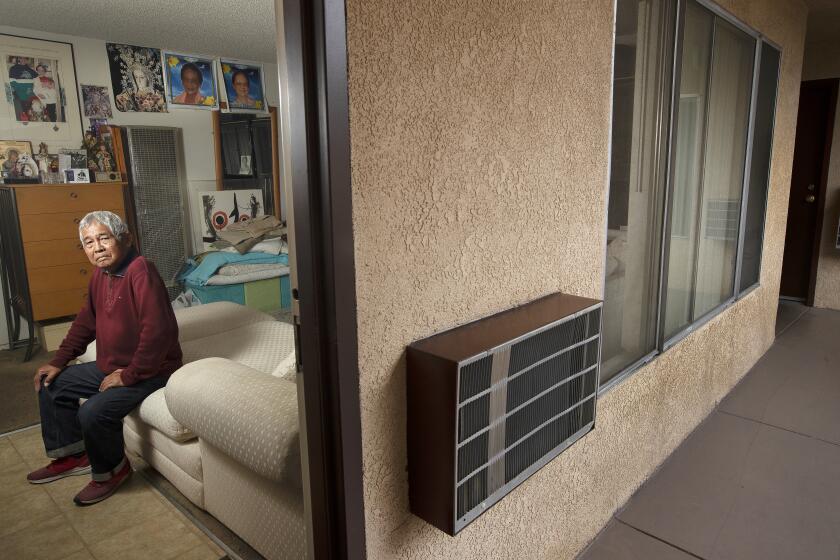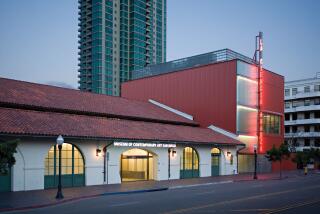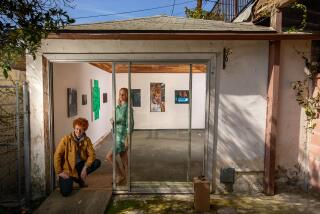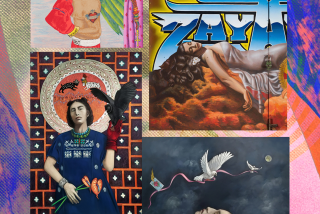Artists spend months, even years, working on a gallery show. What if no one sees it?
Art galleries stand darkened, empty of viewers. Like time capsules, their contents give evidence of the present day, sealed away like relics. Most shows cannot be visited, but they also aren’t coming down. They remain, like so much else, in a state of suspension.
What about the artists, whose efforts of the last months or even years lack a physical audience? Their work is finished and installed, but without viewers, is it complete? Does art need to be seen the way a tree falling in the forest needs to be heard?
“This situation brings up the most basic questions of why we do what we do,” said Kate Petley, a Colorado artist whose first L.A. show opened at Von Lintel Gallery downtown just days before being shuttered by Gov. Gavin Newsom’s stay-at-home order March 19. “Are we doing this for ourselves? I’m happy to hoard all this in my studio until times are better, but I’d rather not. Art has to be shared.”
The Bendix building, which houses a dozen galleries, including Von Lintel, has closed entirely until restrictions are lifted.
“It felt very surreal to open and close a show at the same time,” Petley said. “I’m feeling every emotion I can feel, all of them, within very short spans of time.”
Artists in the same predicament — their L.A. exhibitions on, yet on hold — mirrored that range of emotions, from grief and loss to good-humored equanimity.
“I suppose because of my Buddhist background, I’m not so disturbed by all of this,” said Tom Wudl, a longtime L.A. artist whose mixed-media works on paper went on view at L.A. Louver on March 11. He is sad for people who are ill, but he has not been overcome by a sense of doom. Life has been turned upside down, but that’s always been a possibility, he said. “This would be a good time for people to reflect on not taking anything for granted.”
Wudl said he doesn’t ever assume his work will find viewers, laughing that “I’ve had shows in a gallery that’s very open and no one’s come, so in some ways it’s a very appropriate irony.”
An L.A. Times survey of Los Angeles art galleries on a slimmed-down post-pandemic future. Some are banding together to weather the storm.
Numerous shows with start dates just before the shutdown order have been extended in hope that they might still glean some live traffic when public hours can resume. In the meantime, galleries have stepped up their online presence, offering virtual viewing rooms, streaming walk-throughs and digital catalogs. But there’s broad agreement that nothing can substitute for the encounter in real space, or what Farrah Karapetian describes as “the call and response of physical interactivity.” The scale, sound and texture of her photographic and sculptural work, which had to be paused at Diane Rosenstein Gallery, cannot be fully conveyed online.
“It’s an entirely different sensory experience in person,” she said. Almost the entire show derived from iPhone captures, and now “it’s funny, it goes in a loop — from the phone, through this emotional and physical process, and back,” she said.
Dependence on online viewing is necessary now, but this unusual situation merely exaggerates what has become, for many, ordinary behavior.
“So many people look at work via the internet that you could almost have a show and not really have a show,” said L.A.-based Fran Siegel. Her presentation at Wilding Cran, with British artist Paul Scott, had been planned since December 2018. It was fully installed in mid-March, during a week of pandemic limbo, and never opened.
“The experiential part of my work is important — being in the space with light moving through,” Siegel said. “I only experienced that for one day, the day it was hung.”
Published critical dialogue around work that is on display but off-limits has been largely silenced by the shutdown. Other professionally nourishing aspects of public exposure, from the real-time exchange of ideas on-site to visits from curators, also have been thwarted.
There are also, of course, financial ramifications for artist and gallery alike. Staging a show represents a substantial outlay of time, energy and resources. Sales are less likely now in the depths of a fiscal and public health crisis.
“The financial risk is real,” Petley said. “I feel that I’ll get through this. I don’t know how, or why I believe that, but I do.”
L.A. artist replaces the Statue of Liberty and Mr. Rushmore with migrant farmworkers, enslaved domestic workers and interned Japanese Americans.
Karapetian, who divides her time between San Diego and L.A., identified the sort of collecting that applies to personal work like hers as “faith-based buying — believing that it deserves a place in history or in the home.”
That kind of buying, she said, “is not enabled by stock-market crashes and worries about personal well-being. Museums have no idea what their finances are going to look like. Nobody has any sense of what the state of their finances will be. The show was not meant as a financial safety net for me, but there was a lot of money put into it, and there’s no way to know if it will be recouped.”
Of particular concern to these artists are the missed opportunities to convey relevant messages during this tenuous time. Karapetian’s show was a response to her father’s death last year, and making it helped her deal with illness, hospitals, patience and surrender. “I thought the work might be of psychological service to people unfamiliar with grief,” she said. “We all go through that at some point, but everyone is going through it now.”
Siegel’s collaged, layered and woven pieces have to do with migration — not of populations but of materials and designs.
“The show itself was about translocation, pattern moving from one culture to another in the 1700s,” she said. “And now the pandemic is moving from culture to culture, a virus of pattern. On a conceptual level, it’s so bizarre.”
Wudl’s intricately drawn, painted, gilded and perforated work takes its inspiration from Buddhist scripture.
“The show is about interconnectedness,” he said, “which the virus situation makes graphically clear. It’s about refuge and the sacredness of everything. So perhaps the timing is right, even though the show is not going to be seen.”
In spite of the ambiguous fate of their most recent projects, and the canceled or postponed status of future ones, work goes on. Wudl has seamlessly picked up the thread of ongoing work, steadfast in a practice that is, he said, “its own reward,” not dependent on external recognition or validation.
Petley has registered the uncertainty of the current situation as “an incredibly uncomfortable feeling” but is carrying on in the studio, even recognizing the instability as an opportunity. “I have to keep working, even if there isn’t a reason to. I can be experimental, and that’s good. It opens things up.”
Siegel concurred. “One thing about artists being sequestered — we all know what to do with our time.”
81-year-old Ben Barcelona is L.A.’s most devoted museum-goer. But what happens when the coronavirus shutters culture in California?
More to Read
The biggest entertainment stories
Get our big stories about Hollywood, film, television, music, arts, culture and more right in your inbox as soon as they publish.
You may occasionally receive promotional content from the Los Angeles Times.











